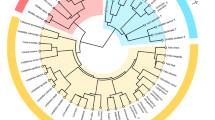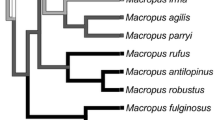Abstract
It has been suggested that larger species of mammals tend to become long-faced when they diverge in size during an evolutionary radiation. However, whether this allometric pattern, reminiscent of ontogenetic changes in skull proportions, is indeed a rule has yet to be thoroughly tested. Using ~ 6000 adult specimens from 14 phylogenetically well separated and ecomorphologically distinctive lineages, 11 orders, and all superorders of the placentals, I tested each group for positive craniofacial allometry (CREA). The evidence supporting CREA is overwhelming, with virtually all analyses showing proportionally longer faces in bigger species. This corroborates previous studies in other groups, consolidates CREA as a pervasive morphological trend in placental evolution and opens important research avenues for connecting micro- and macro-evolution. If found in even more lineages of non-placental mammals, confirmed in birds, and possibly discovered in other tetrapods, CREA could become one of the most general rules of morphological evolution in land vertebrates.





Similar content being viewed by others
References
Bastir, M., Rosas, A., & O’Higgins, P. (2006). Craniofacial levels and the morphological maturation of the human skull. Journal of Anatomy, 209(5), 637–654. https://doi.org/10.1111/j.1469-7580.2006.00644.x.
Boddy, A., McGowen, M., Sherwood, C., Grossman, L., Goodman, M., & Wildman, D. (2012). Comparative analysis of encephalization in mammals reveals relaxed constraints on anthropoid primate and cetacean brain scaling. Journal of Evolutionary Biology, 25(5), 981–994.
Bright, J. A., Marugán-Lobón, J., Cobb, S. N., & Rayfield, E. J. (2016). The shapes of bird beaks are highly controlled by nondietary factors. Proceedings of the National Academy of Sciences United States of America, 113(19), 5352–5357. https://doi.org/10.1073/pnas.1602683113.
Cardini, A., & Polly, P. D. (2013). Larger mammals have longer faces because of size-related constraints on skull form. Nature Communications. https://doi.org/10.1038/ncomms3458.
Cardini, A., Polly, D., Dawson, R., & Milne, N. (2015). Why the long face? Kangaroos and wallabies follow the same ‘rule’ of cranial evolutionary allometry (CREA) as placentals. Evolutionary Biology, 42(2), 169–176. https://doi.org/10.1007/s11692-015-9308-9.
Gayon, J. (2000). History of the concept of allometry. American Zoologist, 40(5), 748–758. https://doi.org/10.1093/icb/40.5.748.
Gould, S. J. (2002). The structure of evolutionary theory. Harvard: Harvard University Press.
Hallgrímsson, B., Brown, J. J. Y., Ford-Hutchinson, A. F., Sheets, H. D., Zelditch, M. L., & Jirik, F. R. (2006). The brachymorph mouse and the developmental-genetic basis for canalization and morphological integration. Evolution & Development, 8(1), 61–73. https://doi.org/10.1111/j.1525-142X.2006.05075.x.
Joganic, J. L., Willmore, K. E., Richtsmeier, J. T., Weiss, K. M., Mahaney, M. C., Rogers, J., et al. (2018). Additive genetic variation in the craniofacial skeleton of baboons (genus Papio) and its relationship to body and cranial size. American Journal of Physical Anthropology, 165(2), 269–285. https://doi.org/10.1002/ajpa.23349.
Klingenberg, C. P. (1998). Heterochrony and allometry: the analysis of evolutionary change in ontogeny. Biological Reviews, 73(1), 79–123. https://doi.org/10.1111/j.1469-185X.1997.tb00026.x.
Lessa, E. P., & Patton, J. L. (1989). Structural constraints, recurrent shapes, and allometry in pocket gophers (genus Thomomys). Biological Journal of the Linnean Society, 36(4), 349–363. https://doi.org/10.1111/j.1095-8312.1989.tb00500.x.
Linde-Medina, M. (2016). Testing the cranial evolutionary allometric ‘rule’ in Galliformes. Journal of Evolutionary Biology, 29(9), 1873–1878. https://doi.org/10.1111/jeb.12918.
Marroig, G., & Cheverud, J. M. (2005). Size as a line of least evolutionary resistance: Diet and adaptive morphological radiation in new world monkeys. Evolution, 59(5), 1128–1142. https://doi.org/10.1111/j.0014-3820.2005.tb01049.x.
McIntosh, A. F., & Cox, P. G. (2016). Functional implications of craniomandibular morphology in African mole-rats (Rodentia: Bathyergidae). Biological Journal of the Linnean Society, 117(3), 447–462. https://doi.org/10.1111/bij.12691.
Meiri, S. (2011). Bergmann’s rule—what’s in a name? Global Ecology and Biogeography, 20(1), 203–207. https://doi.org/10.1111/j.1466-8238.2010.00577.x.
Milne, N., & O’Higgins, P. (2002). Inter-Specific Variation in Macropus Crania: Form, Function and Phylogeny. Journal of Zoology, 256(04), 523–535. https://doi.org/10.1017/S0952836902000572.
Minelli, A. (2009). Possible forms and expected change: an evo-devo perspective on biological evolution. Rendiconti Lincei, 20(4), 273. https://doi.org/10.1007/s12210-009-0063-7.
Mora, M., Olivares, A. I., & Vassallo, A. I. (2003). Size, shape and structural versatility of the skull of the subterranean rodent Ctenomys (Rodentia, Caviomorpha): Functional and morphological analysis. Biological Journal of the Linnean Society, 78(1), 85–96. https://doi.org/10.1046/j.1095-8312.2003.00133.x.
Masayoshi, Tokita, Wataru, Yano, James, Helen F., & Arhat, Abzhanov. (2017). Cranial shape evolution in adaptive radiations of birds: comparative morphometrics of Darwin’s finches and Hawaiian honeycreepers. Philosophical Transactions of the Royal Society B: Biological Sciences, 372(1713), 20150481. https://doi.org/10.1098/rstb.2015.0481.
Radinsky, L. B. (1985). Approaches in evolutionary morphology: A search for patterns. Annual Review of Ecology and Systematics, 16(1), 1–14. https://doi.org/10.1146/annurev.es.16.110185.000245.
Raerinne, J. (2011). Allometries and scaling laws interpreted as laws: A reply to Elgin. Biology and Philosophy, 26(1), 99–111. https://doi.org/10.1007/s10539-010-9203-9.
Renaud, S., & Auffray, J.-C. (2013). The direction of main phenotypic variance as a channel to evolution: Cases in murine rodents. Hystrix, the Italian Journal of Mammalogy, 24(1), 85–93.
Tamagnini, D., Meloro, C., & Cardini, A. (2017). Anyone with a long-face? Craniofacial evolutionary allometry (CREA) in a family of short-faced mammals, the Felidae. Evolutionary Biology, 44(4), 476–495. https://doi.org/10.1007/s11692-017-9421-z.
Tavares, W. C., Pessôa, L. M., & Seuánez, H. N. (2018). Changes in ontogenetic allometry and their role in the emergence of cranial morphology in fossorial spiny rats (Echimyidae, Hystricomorpha, Rodentia). Journal of Mammalian Evolution. https://doi.org/10.1007/s10914-018-9433-1.
Thompson, D. (n.d.).’AW 1917. On growth and form. Cambridge University Press, Cambridge
Usui, K., & Tokita, M. (2018). Creating diversity in mammalian facial morphology: A review of potential developmental mechanisms. EvoDevo, 9(1), 15. https://doi.org/10.1186/s13227-018-0103-4.
van der Geer, A. A. E., Lyras, G. A., Mitteroecker, P., & MacPhee, R. D. E. (2018). From Jumbo to Dumbo: Cranial shape changes in elephants and hippos during phyletic dwarfing. Evolutionary Biology, 45(3), 303–317. https://doi.org/10.1007/s11692-018-9451-1.
Watt, C., Mitchell, S., & Salewski, V. (2010). Bergmann’s rule; a concept cluster? Oikos, 119(1), 89–100. https://doi.org/10.1111/j.1600-0706.2009.17959.x.
West, G. (2017). Scale: The universal laws of growth, innovation, sustainability, and the pace of life in organisms, cities, economies, and companies. London: Penguin.
Acknowledgements
New data, which are published for the first time in this paper, were collected at Museo Civico di Storia Naturale di Milano, Natural History Museum Vienna, National Museum Prague, Museum für Naturkunde, Museum National d’Histoire Naturelle, Hungarian Natural History Museum, Naturhistoriskariksmuseet. I owe a huge thank to all curators, collection managers and staff, including the SYNTHESYS administrators, whose help and support was fundamental. I am also deeply grateful to a number of colleagues who provided technical help and advice. With anticipated apologies for certainly forgetting to explicitly mention several of the many people whom I am in debt with, as well as for listing names in quasi-random order, I would like to thank a lot: Wim Wendelin, Emmanuel Gilissen, Giorgio Bardelli, Görföl Tamás, Gabor Csorba, Virginie Bouetel, Aurelie Verguin, Frank Zachos, Alex Bibl, Krapf Andrea, Petr Benda, Karel Kaderàbek, František Vacek, Manja Voss, Christiane Funk, Detlef Willborn, Mayer Frieder, Daniela Kaltoff, Irene Bisang, Emily Dock Åkerman, Jessica Joganic, Aurélie Siberchicot, David Katz, Mike Collyer, David Warton, Sara Taskinen, Paul O’Higgins, Sarah Elton, David Polly, Krish Seetah, Dan Franklin, Carlo Meloro, Diego Fontaneto and Alessandro Minelli. A special thank also to the greatly missed Colin Groves, for his fundamental contribution to interpreting the preliminary analyses of wild asses, and to Anderson Feijó, who helped with species identification of some of the armadillos. My gratitude goes also to the American Society of Mammalogists, for inviting me to present the preliminary results of this study at their annual conference and for covering all the costs of my trip to the US. This paper is dedicated to the memory of Mario Zambarbieri and Paolo Tongiorgi, my greatest mentors and friends, as well as to that of Colin Groves, a most extraordinary mammalogist, and of Leonard Radinsky, first discoverer of CREA, whose important role I would have acknowledged well before, had I found earlier his surprisingly little cited and yet fundamental contribution on patterns in mammalian morphological evolution. Finally, I am greatly in debt to Julien Claude, an anonymous reviewer and the Editor-in-Chief Benedikt Hallgrimsson, for their most helpful review and appreciation of my work.
Funding
Data collection was funded by SYTHESYS (BE-TAF-2861, SE-TAF-4409, AT-TAF-4816, CZ-TAF-4817, HU-TAF-4818, DE-TAF-4819, FR-TAF-4820) for all lineages except most primates, that were measured for a previous project with Sarah Elton, funded by the Leverhulme Trust (F/00128/T).
Author information
Authors and Affiliations
Contributions
This study was designed, all data were collected, analyses done, and the paper written by CA.
Corresponding author
Ethics declarations
Conflict of interest
I declare no competing interests or conflict of interest.
Electronic supplementary material
Below is the link to the electronic supplementary material.
Rights and permissions
About this article
Cite this article
Andrea, C. Craniofacial Allometry is a Rule in Evolutionary Radiations of Placentals. Evol Biol 46, 239–248 (2019). https://doi.org/10.1007/s11692-019-09477-7
Received:
Accepted:
Published:
Issue Date:
DOI: https://doi.org/10.1007/s11692-019-09477-7




